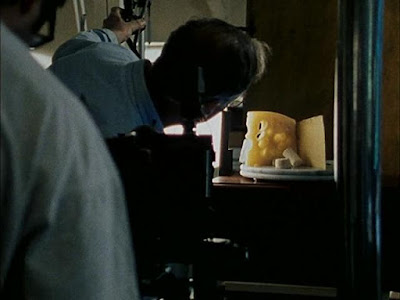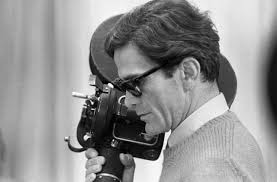
Sitio de enunciación: ocupar el mundo para cuestionar la mirada. No sólo se trata de abrir los ojos, sino de cerrarlos. O puesto de otro modo, abrir los ojos a los modos en que abrimos los ojos – y las formas en que ese abrir de ojos es también un cerrar. ¿Qué dejamos de mirar cuando abrimos los ojos de cierta manera?

“In recent years, I have a hard time judging all these digital images and all these codecs that are coming up. I don’t know what to say about colour correction, because it no longer looks like a photographic image, it’s more like a chalk painting, it has no luminiscence. So there are a lot of changes that have confused me in my aesthetic judgment about how I would like to have an image or whatever. But that’s also liberating, because you must question your standards again, and that is what I’m trying to do” HF, 2014
Farocki nunca se conformó con los sistemas de producción fílmica. El cine, desde su juventud, fue una modalidad del pensamiento crítico y la acción política.
Podríamos intuir que la obra de Farocki es también pensamiento y acción.
Entendimiento de la creación como opuesto a la mera Representación
— ¡Muerte a lo real!, ver en Eccentric Pedagogy. Artistic Research in Times of Crisis.
La apertura de Fuego inextinguible (1969) nos presenta varios elementos clave para relacionarnos con Farocki, su pensamiento y obra.
– La creación como toma de postura
— ¿Qué es la toma? ¿Qué es el corte?
– La creación como herida, sacrificio, fisura
– Genealogía de la mirada – las imágenes – la memoria – y su relación con el mundo
— Imágenes – Recuerdo – Hechos – Contexto
– Operaciones de montaje
– Retóricas de la imagen


62. WORKER: I’m a worker and I work in a vacuum-cleaner factory. My wife could use a vacuum cleaner.
63. WORKER: That’s why I take one part with me every day. At home I want to put together the vacuum cleaner, but no matter what I do, it always turns into a submachine gun.
65. STUDENT: I’m a student, and right now I work at a vacuum-cleaner factory, but I think that the factory is making submachine guns for the Portuguese. But we could really use some proof.
66. STUDENT: That’s why I take one part home with me every day. At home, I want to put the gun together, but no matter what I do, it always turns into a vacuum cleaner.
68. ENGINEER: I’m an engineer and I work for an electrical corporation. The workers think we’re making vacuum cleaners. The students think we’re making submachine guns. This vacuum cleaner can become a useful weapon. This submachine gun can become a useful household gadget.
69. ENGINEER: What we manufacture depends on the workers, students and engineers.
ALGUNAS INTUICIONES RELATIVAS A ESTA PRIMERA OBRA QUE PERMANECEN EN FAROCKI:
– Repetición y diferencia
– Sistemas de producción (e imaginarios)

Obreros saliendo de la fábrica (1995)
“Factories have not attracted film, rather they have rejected it. If we line up 100 years of scenes of people leaving factories, we can imagine that the same shots have been taken over and over again within these 100 years. Like a child who repeats its first word for 100 years, to immortalize its pleasure in that first spoken word. Or like far eastern artists who repeatedly pain the same picture until it is perfect and the artist can enter the painting. When we could no longer Beleive in such perfection, film was invented” HF

“While I was looking for a way to order my collection of material , I thought of the dictionaries, which provide chronological evidence of the usage of a word or expression and then I noticed that there’s nothing that could correspond to a dictionary for film. What should it be called, this thing I was missing? One could ca ll it an “image book”, one could perhaps call it a “thesaurus” or an “image treasury”. one could al so perhaps call it an “archive for cinematic expressions”.” HF

“A contribution of this type aims at sharpening the consciousness of language, and surely there should be something similar to educate the consciousness of cinematic language! I’m mainly concerned that the texts in this archive find their reason purely within themselves, those that don’t derive their right to exist from a system. And so, my first contribution to this imagined archive was Workers Leaving the Factory, and the second The Hands and their Meaning, 1997. Presently, I’m working on a third contribution. I want to do something on prisons: how does the prison appear in film?” HF

THE EXPRESSION OF HANDS (1997)



La iteración como estrategia compositiva (re-compositiva) / Recombinatorias de la imagen — práctica transmedia como necesidad del pensamiento
IMAGINACIÓN DIAGRAMÁTICA

El diagrama, en Guattari, revela no sólo la idea (como sucedía con Pierce) sino la operación de la idea. Es decir, los diagramas revelan las máquinas que sostienen las modalidades del pensamiento y el sentir.
Cómo vemos (1986)


Podemos percibir distintas estrategias de montaje que van del empalme (Eisenstein, Vertov) al desempalme (Peleshian), de la cercanía a la distancia


Imágenes del mundo e inscripciones de la guerra (1989)
“Human beings must lear anew to recognize the pattern of the earth from the perspective of the air” HF
“Despair, and a heroic courage, made out of these numbers, a picture” HF
Reenmarcar como un acto de intervención política
Describir como un acto de insistencia política, como una posibilidad de fracturar la imagen
Inversión del relato histórico
— storytelling – historytelling – themstorytelling (PMZ, 2023)


Naturaleza muerta (1997)





VIDEOGRAMAS DE UNA REVOLUCIÓN, 1992


“La imagen está siempre entre dos campos de fuerza, condenada a ser testigo de una cierta alteridad y, aunque posea un núcleo duro, siempre le falta algo. La imagen siempre es más y, al mismo tiempo, menos que sí misma” Serge Daney
George Didi-Huberman / lo visible vs. lo visual / búsqueda de síntomas
MONTAJE Y REORGANIZACIÓN DEL MUNDO
LEV KULESHOV

SERGEI EISENSTEIN

PIER PAOLO PASOLINI

DZIGA VERTOV

ARTAVAZD PELESHIAN

ANDREI TARKOVSKY


ESFIR SHUB

HARUN FAROCKI





